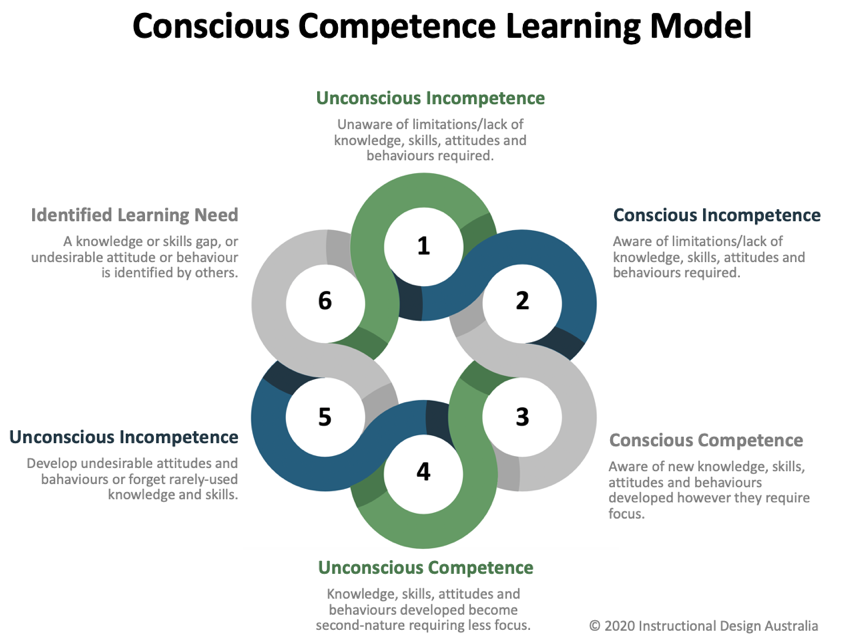Developing and Maintaining Competency in High-Risk Environments
What is the Conscious Competence Learning Model?
The Conscious Competence Learning Model describes a typical experience of learning new knowledge and skills. IDA applies the Model in High Risk Industries to develop and maintain competency.
Firstly, let’s look at how to design training for high risk environments.
High Risk Environments: Developing Competency
Without doubt, the first step to an effective instructional design process is to conduct a Learning Needs Analysis (LNA) (also known as a Training Needs Analysis (TNA)).
In a nutshell, the LNA helps us to determine required shifts in:
- Knowledge, skills, attitudes and behaviours to perform a particular role
- Knowledge and skills gaps observed in current employee abilities
- New knowledge and skills as a result of business change – such as incorporating a new system or steering the organisation in a new direction
An LNA nuts these out to identify learning outcomes that will shape the learning solution/s.
In a high-risk environment, a Risk-based Training Needs Analysis (RBTNA) should also inform your learning solution/s.
An RBTNA is used to identify and score the risks associated with workplace tasks and activities.
This data is key when deciding how each risk will be minimised via learning, assessment and competency management activities. [1]
The RBTNA is essential for the design of a learning architecture and programs that effectively meet both learning needs and risks.
Conscious Competence Learning Model
The Conscious Competence Learning Model describes a typical experience of learning new knowledge and skills:
- Initially, we are unaware of our limitations.
- We then become aware of our lack of knowledge/skills, which fosters a desire to learn
- We develop the knowledge or skill through learning experiences, but applying them takes focus
- After a while, they become second nature [2]
- We may begin to develop undesirable attitudes or behaviours, or forget knowledge and skills we seldomly use [3]
- From this, a learning need is identified through observations or assessments, which brings us back to Phase 1: Unconscious Incompetence
Adapted from:
Office of Rail and Road (2016). Developing and maintaining staff competence.
Expert Program Management (2012). The Conscious Competence Learning Model
Why apply the Conscious Competence Learning Model in High Risk Industries?
Competency plays an important role in reducing health and safety risks [4]. Staff that has not maintained competency may present a risk to themselves, colleagues, the organisation, environment and the public.
Often, competencies that are not maintained are knowledge and skills that staff uses the least.
RBTNAs determine performance characteristics by combining frequency and difficulty ratings – with the least frequent and most difficult tasks allocated the highest rating [5]. This means staff may be unprepared and unskilled when confronted with safety-critical situations.
Further, these skills are often key to managing incident or emergency situations. Because incidents and emergencies occur rarely, we may forget how to respond. The stress and distractions created in such situations may lead to overwhelm – making it difficult to recall processes and employ them appropriately.
Whilst it is essential that staff develops and maintains the competencies required for their role, it is particularly vital in high-risk environments.
When working in high-risk industries such as rail, health, mining and law enforcement, IDA develops competency plans that incorporate refresher training and/or up skilling to ensure staff ‘use it’, ‘review it’ or ‘improve it’ – rather than ‘lose it’!
Keeping Up with Technological Advancements
Many high-risk industries seek to eliminate human factors that may contribute to incidents. Metro Trains Sydney (MTS) recently opened Australia’s first driverless train [6], aircrafts can land by themselves [7], and automated and assistive technologies that support staff in conducting safety-critical tasks are becoming increasingly common [8].
Whilst the incorporation of technological advancements across organisational practices aims to reduce risk, it also changes organisational policies and procedures. To mitigate against any potential safety issues around changes to policies and procedures, a system of communication and competency management must be in place.
Competency Management Systems (CMS)
Competency management systems (CMS) are designed to manage data regarding staff competencies [9]. They are used to manage competency profiles for staff and to identify knowledge and skills gaps, as well as staff requiring refresher training or up skill.
Summary
Does your organisation have a competency management system in place?
Have you considered ongoing competency management strategies – such as refresher training and up skilling?
DLD has specific expertise in high-risk industry learning and training programs.
Contact us so we can help you to support and maintain a safe workplace.
Related Articles and Blogs
- Our Design Method
- Our Work
- Embedding Activities in Learning Design: Why Leaders Matter
- Learning Needs Analysis Templates
Read more of our blog articles here.
Contact Instructional Design Australia
Instructional Design Australia (IDA) provides instructional design services including the application of the Conscious Competence Learning Model. With team members in Melbourne, Sydney, Brisbane and Perth, IDA will enable your people to engage, learn and perform.
Office
E: [email protected]
Ph: 1300 528 736
Michael Peart
E: [email protected]
Ph: 0434 075 231
Bianca Schimizzi
E: [email protected]
Ph: 0416 013 623
References
[1] RSSB (2011). Operations Management. Review of GB driver training and development of leading practice models for the industry. Guide to the process and template. Retrieves from https://www.yumpu.com/en/document/read/25887407/risk-based-training-needs-analysis-guide-t-rssb
[2] Expert Program Management (2012). The Conscious Competence Learning Model. Retrieved from https://expertprogrammanagement.com/2012/08/the-conscious-competence-learning-model/
[3] [4] [5] Office of Rail and Road (2016). Developing and maintaining staff competence: Railway Safety Publication 1. Retrieved from https://orr.gov.uk/__data/assets/pdf_file/0016/4264/developing-and-maintaining-staff-competence-rsp1.pdf?web=1
[6] RailTech.com (May 27, 2019). First driverless metro launched in Australia. Retrieved from https://www.railtech.com/infrastructure/2019/05/27/first-driverless-metro-launched-in-australia/?gdpr=accept
[7] Flight Deck Friend.com (n.d.). Can a Plane Land Automatically? Retrieved from https://www.flightdeckfriend.com/can-a-plane-land-automatically
[8] Fowler, Abigail & Golightly, David & Sharples, Sarah & Harvey, Catherine & Wilson, Max & Gibson, Huw. (2019). Human performance in rail: current assessment and future opportunities.
[9] Cognology (n.d.). Competency Management System. Retrieved from https://www.cognology.com.au/products/competency_assessment/




